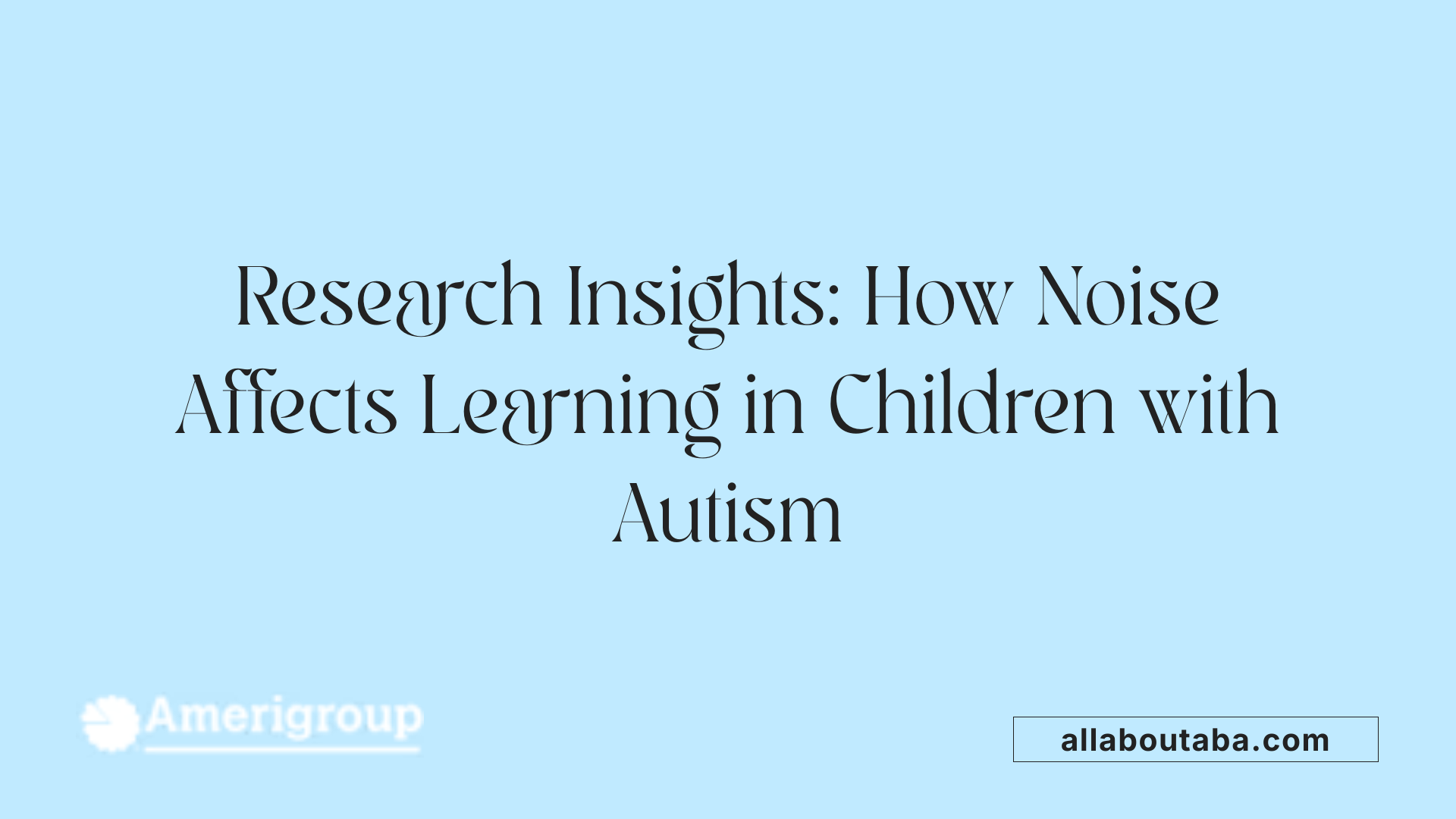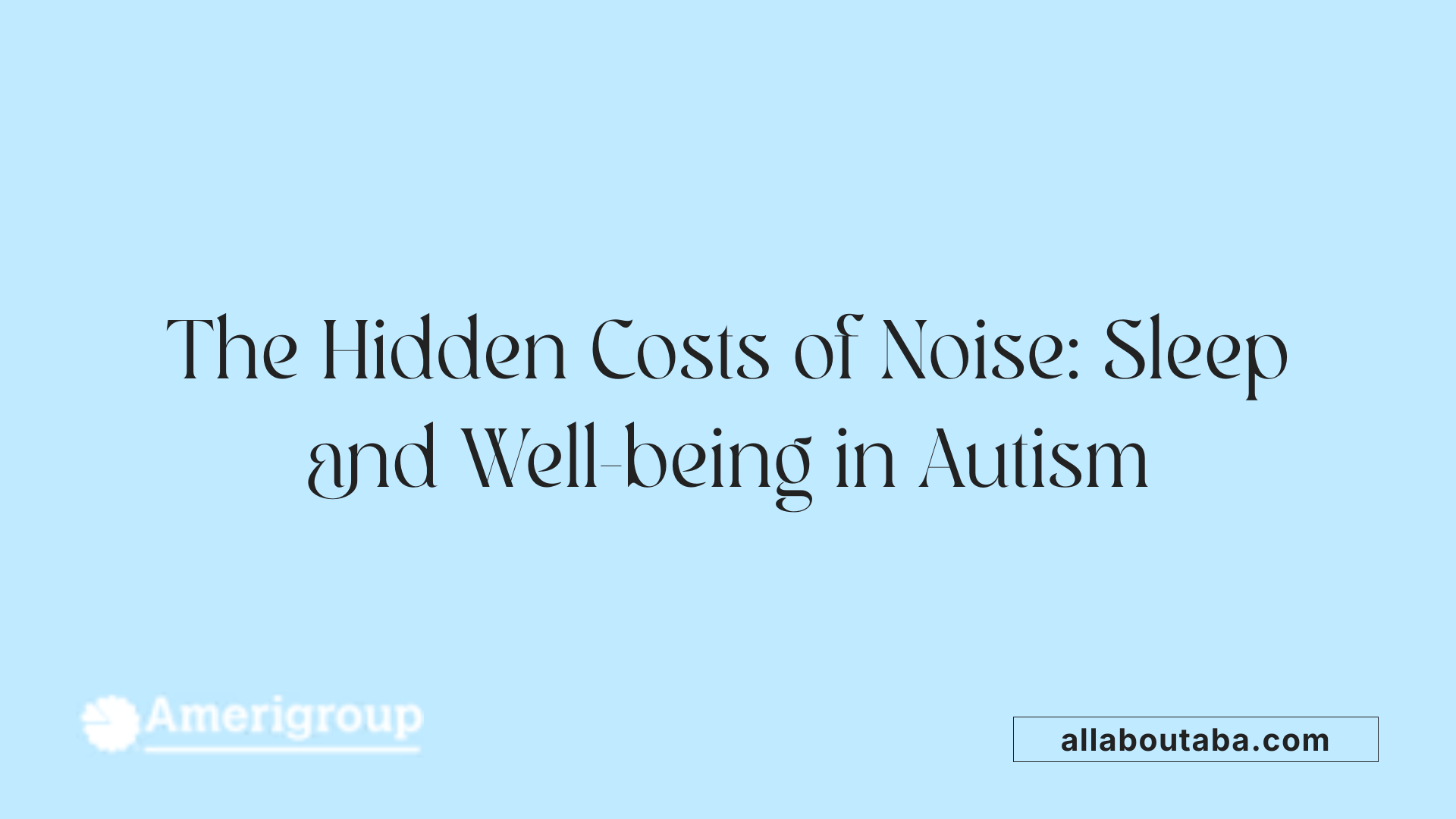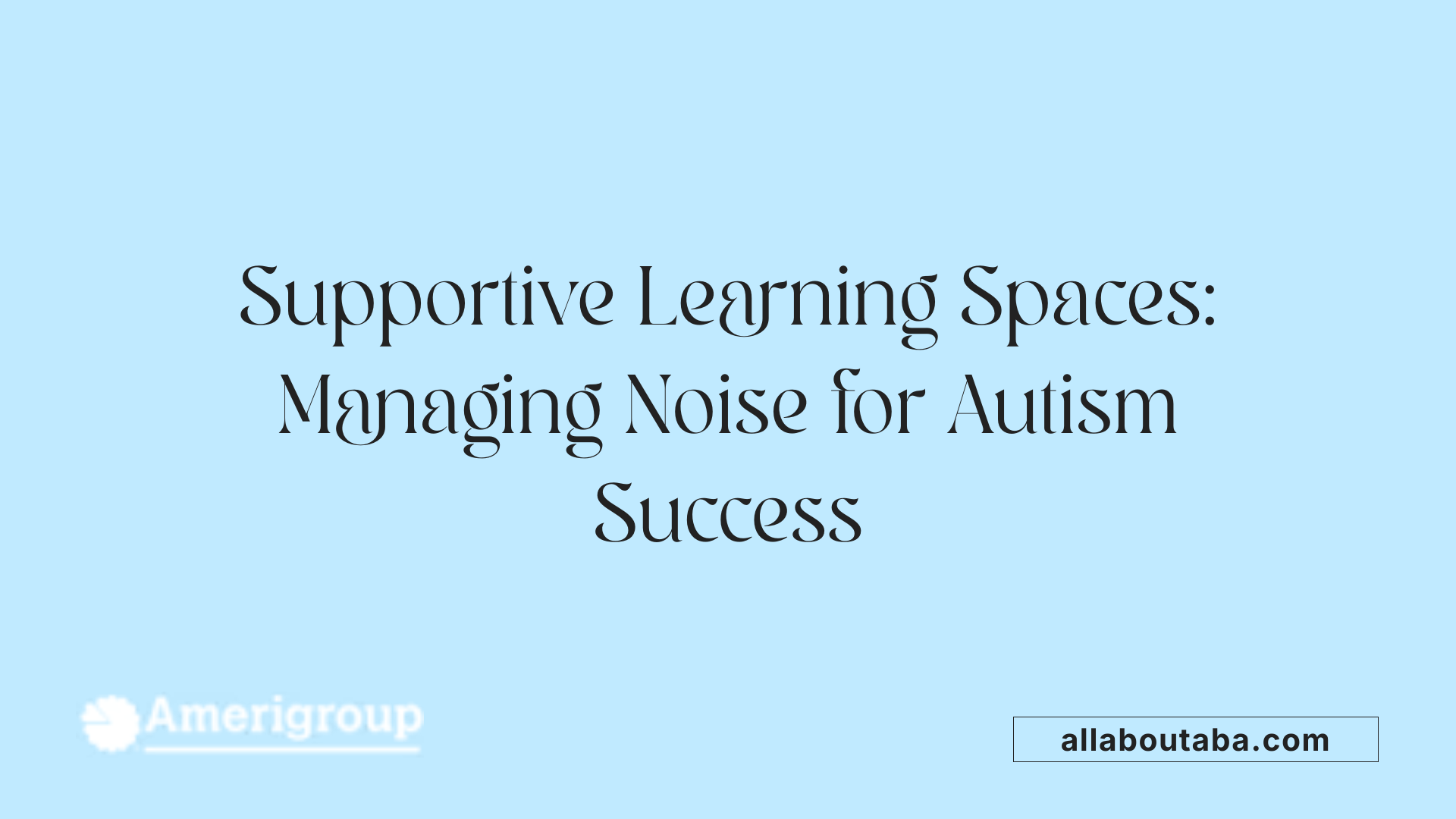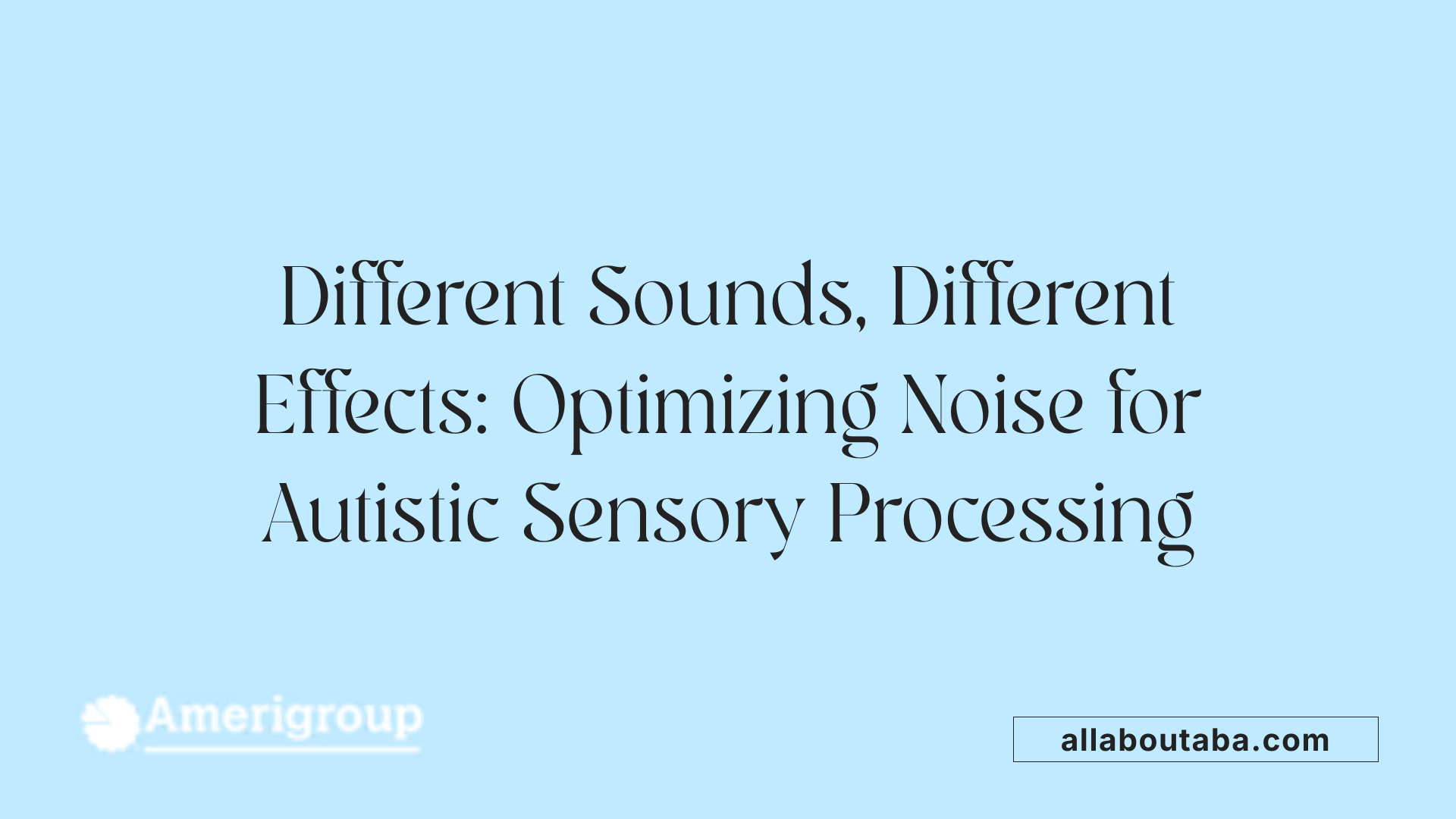Autism And The Impact Of Environmental Noise On Learning
Understanding the Critical Role of Environmental Noise
Environmental noise profoundly influences the educational experiences and well-being of children with autism. From classroom acoustics to broader outdoor environments, managing auditory stimuli is essential for fostering inclusive, supportive learning spaces. This article explores how noise impacts children with autism from multiple perspectives—ranging from sensory processing to behavioral responses—and discusses practical strategies for educators, designers, and policymakers to create environments optimized for neurodiverse learners.
The Impact of Environmental Noise on Learning for Children with Autism
How does environmental noise affect children with autism in learning environments?
Children with Autism Spectrum Disorder (ASD) often face heightened sensitivities to sounds that most neurotypical children may ignore or barely notice. This sensory processing challenge can turn ordinary classroom noises — like chatter, footsteps, or equipment hums — into sources of distress and distraction. Autistic children may cover their ears, become overwhelmed, or withdraw socially, making active participation difficult.
Such noise sensitivity impacts their ability to focus and comprehend spoken instructions. For example, high background noise levels can obscure speech, reducing understanding and leading to frustration. Teachers report that students with autism struggle with speech and language, especially in noisy environments, affecting their learning outcomes.
Poor classroom acoustics—characterized by excessive reverberation, echoes, and external noise—further exacerbate these issues. When sounds bounce excessively or external noises intrude, communication channels weaken, leading to misunderstandings and decreased engagement. Sharp, sudden sounds or continuous background noise can elevate stress levels, impair emotional regulation, and hinder attention.
Research suggests that implementing acoustic modifications can make a significant difference. The use of soundproof walls, acoustic tiles, carpets, and draperies reduces reverberation and external noise, creating a calmer environment. Such measures improve the signal-to-noise ratio, allowing children with ASD to better focus on speech and participate meaningfully.
In sum, environmental noise and poor acoustics directly influence the behavioral and learning profiles of children with autism. Managing these factors through thoughtful classroom design and sound treatments is essential for fostering inclusive, supportive learning spaces that accommodate their unique sensory needs.
Scientific Evidence on Noise and Autism Learning Challenges

How does environmental noise affect learning and behavior in children with autism?
Research shows that environmental noise plays a significant role in shaping the learning experiences of autistic children. Many individuals on the autism spectrum exhibit hyper-reactivity to sounds, meaning even modest noise levels can trigger discomfort or distress. This heightened sensitivity often results in behaviors like covering ears, withdrawal, or agitation, which interfere with concentration and engagement.
Classrooms and public environments filled with background noise, reverberation, or sudden sounds can make it difficult for autistic students to process speech and participate effectively. Noise pollution also increases stress levels, triggers sensory overload, and can contribute to behavioral issues such as withdrawal or meltdowns.
Studies utilizing real-world simulations of school and cafeteria environments under reverberant and sound-absorbing conditions reveal that many existing spaces do not meet the acoustic needs of autistic children unless acoustic treatments are employed. This highlights the importance of designing spaces with reduced noise levels to foster inclusive learning.
What does scientific research say about the impact of environmental noise on learning for individuals with autism?
Scientific findings emphasize that environmental noise levels directly influence the ability of autistic individuals to focus, learn, and communicate. Increased ambient noise can lead to longer reaction times, more errors in cognitive tasks, and reduced attentional capacity. For example, environmental factors like temperature and sudden loud noises impair attentional performance and increase cognitive load.
Moreover, autistic individuals often report environments as noisy or uncomfortable even when the noise levels may be moderate. These tendencies are linked to atypical sensory processing, making typical acoustic standards insufficient for their needs.
The use of auditory masking devices like white, pink, or brown noise helps create a predictable, steady sound environment that can significantly mitigate stress, improve concentration, and support sleep. Soundproofing strategies, noise-reducing headphones, and reducing external noise sources are effective interventions supported by research.
What are some strategies for managing noise in educational and community environments?
To support autistic learners, a variety of noise management strategies are recommended:
- Installing sound-absorbing materials such as acoustic tiles, carpets, and draperies to reduce reverberation.
- Designing classrooms with soundproof walls and windows to minimize external noise.
- Using noise-canceling headphones and personal listening devices for individuals with auditory sensitivities.
- Implementing quiet zones or rooms where students can retreat if feeling overwhelmed.
- Employing steady background sounds like white, pink, or brown noise to mask disruptive noises.
- Modifying lighting and visual clutter to reduce overall sensory overload.
Such measures not only support learning and social participation but also improve overall wellbeing by reducing sensory stress. Prioritizing acoustic comfort through thoughtful environmental design is vital to fostering inclusive spaces for autistic individuals.
| Acoustic Strategies | Implementation Examples | Benefits |
|---|---|---|
| Soundproofing | Soundproof walls and windows | Minimize external noise intrusion |
| Acoustic treatments | Tiles, carpets, draperies | Reduce reverberation and echo |
| Personal noise reduction devices | Headphones, earplugs | Protect sensitive ears, improve focus |
| Ambient noise masking | White, pink, brown noise generators | Create steady, masking background sound |
| Environmental modifications | Quiet zones, minimized visual clutter | Decrease sensory overload, enhance calmness |
Overall, integrating these acoustic interventions helps create more accessible and supportive learning environments, fostering better educational outcomes and well-being for autistic children.
Broader Impacts of Noise on Autistic Children’s Health and Behavior

What are the broader implications of environmental noise on sleep, behavior, and overall well-being of children with autism?
Environmental noise plays a significant role in shaping the health and daily lives of children with autism. Excessive noise from traffic, airplanes, and indoor sources like televisions can disrupt sleep patterns, leading to difficulties in falling asleep, night waking, and reduced sleep quality. These disruptions not only affect rest but also increase daytime irritability, hyperactivity, and difficulty concentrating.
Research indicates that specific interventions, such as white noise, can provide a steady auditory environment that masks unpredictable background sounds. This steady sound can help children with ASD manage sensory overload, improve their ability to self-regulate, and reduce hyperactivity levels.
For instance, exposure to loud or sudden noises, especially from aircraft or urban environments, has been associated with increased night waking and bedtime resistance, further impairing their daytime functioning. Poor sleep and heightened sensitivity to noise can contribute to ongoing behavioral challenges, such as emotional outbursts or social withdrawal.
Moreover, environmental noise may trigger stress responses in children with autism. Elevated stress levels can worsen behavioral and emotional health, creating a cycle that hampers their overall development and quality of life. Managing noise exposure through environmental modifications—like soundproofing, using noise-canceling devices, and incorporating calming auditory stimuli—can mitigate these impacts.
In summary, controlling environmental noise and applying tailored strategies can greatly enhance sleep quality, reduce stress, and support emotional stability, ultimately fostering better daily functioning and well-being for children with autism.
| Aspect | Impact | Strategies |
|---|---|---|
| Sleep disturbances | Increased night waking, sleep resistance | White noise, noise-canceling headphones |
| Stress responses | Elevated anxiety, hyperactivity | Noise management, calming auditory inputs |
| Behavioral and emotional health | Increased irritability, social withdrawal | Environmental modifications, routine sticking to quiet environments |
Proper management of acoustic environments is essential in supporting the health and development of children with autism, promoting peaceful sleep, reducing stress, and fostering emotional resilience.
Effects of Noise on Sensory and Educational Regulation in Autism

What are the effects of environmental noise on the academic, behavioral, and sensory regulation of children with autism?
Children with Autism Spectrum Disorder (ASD) often face significant challenges due to environmental noise. High noise levels and reverberant spaces, such as busy classrooms or cafeterias, can cause sensory overload. This overload manifests as heightened stress, frustration, and in some cases, behavioral outbursts. Many autistic children exhibit increased sensitivity to auditory stimuli—hyperacusis or phonophobia—that makes loud or sudden sounds overwhelming.
The impact extends beyond sensory discomfort. Noise pollution can impair their ability to focus, understand speech, and participate actively in learning. Atypical neural processing of sounds—marked by delayed or abnormal brain responses—further complicates their perception of auditory stimuli, leading to difficulties in sensory regulation and increased emotional distress.
Research indicates that strategies to reduce noise, like soundproofing and the use of noise-cancelling devices, are effective in creating more manageable environments. Implementing acoustic tiles, carpets, and sound-attenuating materials can notably decrease echo and background noise, improving comfort and concentration.
In summary, minimizing environmental noise and considering the sensory sensitivities of children with autism are critical steps toward supporting their educational success and emotional well-being.
| Aspect | Impact | Strategies for Improvement | Additional Notes |
|---|---|---|---|
| Sensory Overload | Increased stress and withdrawal | Use of noise-cancelling headphones, quiet zones | Noise sensitivity is often heightened in ASD, requiring tailored approaches |
| Attention and Focus Challenges | Reduced task completion; difficulty understanding speech | Acoustic modifications to classrooms, background noise reduction | Tuning acoustics can markedly enhance engagement |
| Neural Sound Processing | Abnormal brain responses; delayed reactions | Soundproofing, controlled auditory environments | Neural differences in ASD mean even moderate noise can be disruptive |
Taking measures to address these factors can greatly improve environments for children with autism, fostering better learning, social interaction, and emotional regulation.
Types of Noise and Their Effects on Sensory Processing

How do different types of noise (white, pink, brown) affect the sensory processing and learning of autistic individuals?
Autistic individuals often experience heightened sensitivities to environmental sounds, which can significantly influence their comfort, attention, and learning in various settings. Different types of noise—white, pink, and brown—offer distinct acoustic features and can serve different purposes in managing sensory input.
White noise contains all frequencies at equal intensity, creating a steady, consistent sound that can effectively mask sudden or unpredictable noises. This stability helps reduce sensory overload and creates a predictable auditory environment, easing anxiety and improving concentration for many autistic individuals.
Pink noise balances the distribution of frequencies more evenly, with lower frequencies slightly more emphasized. Its gentle, natural sound profile makes it especially suitable for relaxation and sleep, helping to prevent sensory overload without being overly intrusive.
Brown noise emphasizes even lower frequencies, providing a grounding and soothing background. Its deep, muffled sound can help mitigate high-frequency distractions, fostering a calm atmosphere conducive to focus and emotional regulation.
Despite these general effects, individual sensitivities vary greatly. Some autistic individuals might find certain noise types calming and supportive of concentration, while others may experience increased distraction or discomfort. For example, those with auditory hypersensitivity could find white noise intrusive if it is too loud, whereas brown noise might be more soothing.
Research demonstrates that properly tailored auditory stimuli—like pink or brown noise—can improve sensory regulation and postural stability. When applied thoughtfully, these sounds may help autistic learners better manage sensory overload, enhance focus, and create a more inclusive learning environment.
Understanding each person’s unique sensitivities is crucial. Using consistent, predictable noise sources can serve as a practical strategy to reduce environmental stressors, support emotional well-being, and improve learning outcomes for students on the autism spectrum.
| Noise Type | Acoustic Characteristics | Typical Uses | Suitability for Autistic Individuals |
|---|---|---|---|
| White Noise | All frequencies at equal intensity | Mask sudden sounds, aid sleep | May be calming or overwhelming depending on sensitivity |
| Pink Noise | Balanced frequencies with emphasis on lower tones | Relaxation, sleep | Often soothing, promotes calmness |
| Brown Noise | Deep, low frequencies | Grounding, reduce high-frequency distractions | Particularly calming for those sensitive to sharp sounds |
Choosing the right type of noise should be based on individual preferences and sensory profiles. This personalized approach can significantly enhance sensory processing, reduce stress, and improve educational engagement.
Fostering Better Learning Through Noise Management
Effective management of environmental noise is essential for nurturing inclusive, supportive educational spaces for children with autism. Incorporating sound-absorbing materials, providing designated quiet areas, and selecting appropriate auditory stimuli like calming noise types can significantly reduce sensory overload and enhance learning, behavior, and emotional wellbeing. Furthermore, updates to acoustic standards and best practices can guide schools and policymakers towards creating environments that recognize the unique sensory needs of autistic learners, ultimately fostering a more equitable and nurturing educational system.
References
- The impact of noise and soundscape on children with ...
- Implications of Sensory Processing and Attentional ...
- Noise and autism spectrum disorder in children
- Autistic Students' Sensitivity to Classroom Noise
- Understanding the listening difficulties of autistic people
- How Noise Affects Children
- The influence of indoor temperature and noise on autistic ...
Other articles
Recent articles

The Role Of Teachers In Fostering Autism Peer Acceptance

Using Art Therapy To Support Children With Autism

Autism And Strategies For Addressing Sensory Defensiveness

Autism And The Benefits Of Structured Leisure Activities

How To Support Autistic Students During Exam Season

Autism And Goal Setting For Personal Growth

How To Use Gamification In Autism Learning Programs

How Schools Can Reduce Bullying Of Autistic Students

Early Intervention Strategies For Autism Spectrum Disorder

The Role Of Therapists In Autism Life Skills Coaching

How To Support Autistic Individuals In Crisis Situations

Autism And Self-Care Routines For Stress Management

Understanding Echolalia And Its Role In Autism Communication

Autism And Fine Arts Education Benefits

The Impact Of Multisensory Learning On Autism Education

How Family Counseling Supports Autism Household Dynamics

Best Practices For Inclusive Playgrounds For Autism

Best Practices For Autism-Friendly Shopping Centers

How Autism Affects Fine Motor Skill Development

Best Ways To Introduce Sensory Activities Into Daily Routines

How Sports Teams Can Be Inclusive Of Autistic Players

Autism And Strategies For Building Workplace Resilience

Autism And The Impact Of Hormonal Changes During Puberty

How To Support Autistic Students In Foreign Language Classes

Best Ways To Teach Money Skills To Teens With Autism

Supporting Siblings Of Children With Autism

Autism And Co-Occurring Gastrointestinal Disorders

The Role Of Art Projects In Autism Sensory Integration

How Schools Can Incorporate Sensory Break Spaces

Best Practices For Autism Sensory Regulation At School

Autism And Strategies For Teaching Organizational Skills

Understanding The Relationship Between Autism And Anxiety Disorders

Autism And Life Planning For Long-Term Care

Exploring Visual Supports In Autism Education

Ways To Encourage Social Interaction In Children With Autism

The Connection Between Autism And Dyscalculia

The Role Of Occupational Therapy In Transition Planning For Autism

The Role Of Physical Therapists In Autism Motor Skills Support

How To Teach Decision-Making Skills To Autistic Young Adults

The Connection Between Autism And Epilepsy

Best Practices For Transitioning Autistic Children Into New Schools

Autism And Time Management Challenges In Adulthood

The Role Of Visual Arts In Autism Communication Development

How To Address Tactile Defensiveness In Autism

Best Practices For Telehealth Autism Therapy

How To Help Autistic Children Develop Friendship Skills

How Schools Can Support Autistic Students In Career Prep

Best Strategies For Autism-Friendly Event Planning

Understanding Noncontingent Reinforcement In Autism Behavior Plans

How Drama Therapy Benefits Autistic Individuals

Best Practices For Autism-Friendly Fitness And Recreation Centers

Best Ways To Promote Healthy Social Media Use For Autistic Teens

How To Help Autistic Children Cope With Public Speaking

Autism And Strategies For Managing Unexpected Changes

Best Podcasts About Autism For Parents And Educators

Autism And The Impact Of Seasonal Changes On Behavior

The Role Of Diet In Managing Co-Occurring Conditions With Autism

Sleep Challenges In Autism And Practical Solutions

Best Ways To Build Daily Routines For Autistic Children

Best Practices For Supporting Autistic Entrepreneurs

Autism And Strategies For Navigating Large Social Gatherings

Adaptive Sports And Recreational Activities For People With Autism

Autism And The Benefits Of Story-Based Learning Activities

Understanding The Role Of Play In Autism Development

Autism And The Impact Of Environmental Noise On Learning

How To Create Autism-Friendly Community Spaces

Autism And Chronic Health Conditions: What To Know

The Role Of Care Managers In Autism Life Planning

How To Teach Social Boundaries To Autistic Children

How Autistic Individuals Experience Empathy Differently

How To Support Autistic Employees In Remote Work Settings

Autism And The Relationship Between Motor Skills And Learning

How To Create Community Resource Guides For Autism Families

How To Teach Daily Living Skills To Autistic Teens

Autism And The Impact Of Mind-Body Practices On Stress Reduction

Autism And The Benefits Of Outdoor Group Activities

How To Create Autism-Friendly Sensory Paths In Schools

Best Practices For Autism-Friendly Park And Recreation Areas

Autism And Strategies For Reducing School Refusal

Supporting Autistic Individuals In Public Speaking

The Role Of Diet In Managing Autism Symptoms

The Benefits Of Gardening Clubs For Autism Social Development

How To Prepare Autistic Children For Dental Visits

Autism And Employment: Career Paths That Work

Best Practices For Autism-Friendly Hotels And Lodging

The Impact Of Screen Time On Autism Development

Autism Screening Tools For Early Childhood

The Role Of Physical Exercise In Autism Therapy

Best Strategies For Supporting Autistic College Students

The Role Of Technology In Autism Early Detection

Sensory-Friendly Classroom Design Ideas For Autistic Students

The Role Of Speech Therapy In Building Social Communication Skills

Best Strategies For Handling Autistic Burnout In Adults

Autism And The Importance Of Predictability In Routine

Autism And Peer Education: Teaching Acceptance In Schools

Best Practices For Sensory-Friendly Libraries And Reading Rooms

Self-Advocacy Skills For Autistic Adults

The Role Of Technology In Autism Peer Communication

Promoting Physical Activity In Children With Autism

How To Prepare Autistic Children For Medical Procedures
We’re All About You, Your Family, and Your Child

